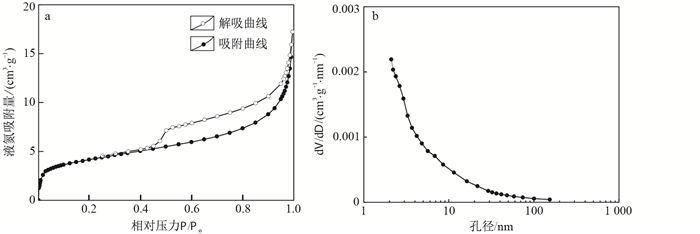Experimental study about the gas slip flow in Longmaxi shales from the southern Sichuan Basin
-
摘要: 针对页岩储层气体滑脱效应特征及其影响机制不清问题,选取四川盆地长宁地区志留系龙马溪组页岩样品,开展了低温氮气吸附孔隙结构表征实验,并利用非稳态脉冲衰竭方法测量了不同围压下氦气、氮气在页岩岩心上的气体渗透率,分析了平均孔隙压力、气体类型、围压对滑脱效应的影响,建立了滑脱因子的预测关系式。结果表明:压力低于2.5 MPa时,页岩气体滑脱效应不能忽略。由于“分子筛效应”的影响,页岩克氏渗透率与测试流体介质类型有关,以氦气为流动介质测试得到的克氏渗透率大于以氮气为流动介质的测试结果。滑脱效应与气体类型有关,龙马溪组页岩的氦气滑脱因子约为氮气滑脱因子的1.7倍。利用滑脱因子计算得到围压为10~40 MPa时,氦气在页岩上的有效渗流孔径为113~166 nm,氮气的有效渗流孔径为66~99 nm,均远大于液氮吸附法测试的平均孔径。建立了龙马溪组页岩气体滑脱因子与克氏渗透率的幂函数关系,为页岩气流动模型的建立提供了基础。Abstract: In order to clarify the gas slip flow effect and its influencing mechanism of shale gas reservoirs, low-temperature nitrogen adsorption measurements were performed on the Silurian Longmaxi Formation shales from the Sichuan Basin. Pore structure characteristics of shales were described based on nitrogen adsorption-desorption isotherms. Non-steady state gas flow experiments on gas shales were carried out to obtain the apparent permeability coefficients of helium and nitrogen. The effects of pore pressure, gas types, confining pressure on gas slippage were discussed. Results show that gas slippage cannot be neglected when the pore pressure is less than 2.5 MPa. The Klinkenberg corrected permeability coefficients of shales are gas-dependent due to the "molecular sieving effect". The Klinkenberg corrected permeability of helium on shales is larger than that of using nitrogen. Gas slippage factors are also related to gas types. Helium slippage factor of shales is about 1.7 times of nitrogen slippage factor. The effective transport pore diameter of helium on shales with the confining pressure being 10-40 MPa ranges from 113 to 166 nm, while that of nitrogen is between 66 and 99 nm. These values are significantly larger than that derived from low-temperature nitrogen adsorption. A power function is utilized to fit the gas slippage factor and permeability of shales and can be used to predict gas flow in shales.
-
Key words:
- shale /
- slippage effect /
- permeability /
- transport pore diameter /
- Sichuan Basin
-
表 1 龙马溪组页岩氦气和氮气测试的克氏渗透率、滑脱因子和等效渗流孔径
Table 1. Klinkenberg-corrected permeability of helium and nitrogen, slip factors and equivalent seepage pore diameter
围压
Pc/MPa氦气 氮气 克氏渗透率/
10-6 μm2滑脱因子/
MPa渗流孔径①/
nm克氏渗透率/
10-6 μm2滑脱因子/
MPa渗流孔径①/
nm10 0.40 0.43 166 0.31 0.24 99 20 0.29 0.50 141 0.25 0.29 83 30 0.23 0.56 127 0.22 0.33 74 40 0.20 0.63 113 0.19 0.37 66 注:①为等效渗流孔径,是根据滑脱因子的表达式(3)转换得到 -
[1] 邹才能, 杨智, 崔景伟, 等. 页岩油形成机制、地质特征及发展对策[J]. 石油勘探与开发, 2013, 40(1): 14-26. https://www.cnki.com.cn/Article/CJFDTOTAL-SKYK201301003.htm [2] 马新华, 谢军. 川南地区页岩气勘探开发进展及发展前景[J]. 石油勘探与开发, 2018, 45(1): 1-9. https://www.cnki.com.cn/Article/CJFDTOTAL-SKYK201801020.htm [3] 聂海宽, 张金川, 李玉喜. 四川盆地及其周缘下寒武统页岩气聚集条件[J]. 石油学报, 2011, 32(6): 959-967. doi: 10.3969/j.issn.1001-8719.2011.06.020 [4] Javadpour F, Fisher D, Unsworth M. Nano-scale gas flow in shale gas sediments[J]. Journal of Canadian Petroleum Technology, 2007, 46(10): 54-60. http://www.researchgate.net/publication/250092811_Nanoscale_Gas_Flow_in_Shale_Gas_Sediments [5] 陈林, 陈孝红, 张保民, 等. 鄂西宜昌地区五峰组-龙马溪组页岩储层特征[J]. 地质科技通报, 2020, 39(2): 54-61. http://dzkjqb.cug.edu.cn/CN/abstract/abstract9974.shtml [6] 杨峰, 宁正福, 胡昌蓬, 等. 页岩储层微观孔隙结构特征[J]. 石油学报, 2013, 34(5): 301-311. https://www.cnki.com.cn/Article/CJFDTOTAL-SYXB201302013.htm [7] 蔡全升, 陈孝红, 王传尚, 等. 上奥陶统五峰组-下志留统龙马溪组黑色岩系笔石赋存特征与堆积模式[J]. 地质科技通报, 2020, 39(2): 43-53. http://dzkjqb.cug.edu.cn/CN/abstract/abstract9973.shtml [8] 刘安, 陈孝红, 李培军, 等. 宜昌天阳坪断裂两侧页岩气保存条件对比研究[J]. 地质科技通报, 2020, 39(2): 10-19. http://dzkjqb.cug.edu.cn/CN/abstract/abstract9970.shtml [9] 孙中良, 王芙蓉, 侯宇光, 等. 潜江凹陷潜江组页岩中可溶有机质赋存空间表征及影响因素分析[J]. 地质科技情报, 2019, 38(6): 81-90. https://www.cnki.com.cn/Article/CJFDTOTAL-DZKQ201906011.htm [10] 乔辉, 贾爱林, 贾成业, 等. 页岩气储层关键参数评价及进展[J]. 地质科技情报, 2018, 37(2): 157-163. https://www.cnki.com.cn/Article/CJFDTOTAL-DZKQ201802022.htm [11] 程璇, 徐尚, 郝芳, 等. 松辽盆地嫩江组富有机质页岩有机孔隙成因[J]. 地质科技情报, 2019, 38(4): 62-69. https://www.cnki.com.cn/Article/CJFDTOTAL-DZKQ201904008.htm [12] Yang F, Ning Z F, Wang Q, et al. Pore structure characteristics of Lower Silurian shales in the southern Sichuan Basin, China: Insights to pore development and gas storage mechanism[J]. International Journal of Coal Geology, 2016, 156(3): 12-24. http://www.sciencedirect.com/science/article/pii/S0166516215301002 [13] Javadpour F. Nanopores and apparent permeability of gas flow in mudrocks (shales and siltstone)[J]. Journal of Canadian Petroleum Technology, 2009, 48(8): 16-21. doi: 10.2118/09-08-16-DA [14] 周红, 郭超华, 朱芳冰, 等. 灰关联法在页岩气资源丰度敏感性研究中的应用[J]. 地质科技情报, 2018, 37(4): 196-201. https://www.cnki.com.cn/Article/CJFDTOTAL-DZKQ201804027.htm [15] 端祥刚, 胡志明, 常进, 等. 页岩储层气体流动能力实验研究[J]. 特种油气藏, 2019, 26(3): 143-147. doi: 10.3969/j.issn.1006-6535.2019.03.027 [16] Wu K L, Li X F, Guo C H, et al. A unified model for gas transfer in nanopores of shale-gas reservoirs: Coupling pore diffusion and surface diffusion[J]. SPE Journal, 2016, 21(5): 1-29. http://www.researchgate.net/publication/299522550_A_Unified_Model_for_Gas_Transfer_in_Nanopores_of_Shale-Gas_Reservoirs_Coupling_Pore_Diffusion_and_Surface_Diffusion [17] Fathi E, Akutlu I Y. Lattice Boltzmann method for simulation of shale gas transport in kerogen[J]. SPE Journal, 2012, 18(1): 27-37. http://www.researchgate.net/publication/254534945_Lattice_Boltzmann_Method_for_Simulation_of_Shale_Gas_Transport_in_Kerogen [18] Cui X, Bustin A M M, Bustin R M. Measurements of gas permeability and diffusivity of tight reservoir rocks: Different approaches and their applications[J]. Geofluids, 2009, 9(2): 208-223. doi: 10.1111/j.1468-8123.2009.00244.x [19] Firouzi M, Alnoaimi A, Kovscek A, et al. Klinkenberg effect on predicting and measuring helium permeability in gas shales[J]. International Journal of Coal Geology, 2014, 123(3): 62-68. http://www.sciencedirect.com/science/article/pii/S0166516213002115 [20] 高树生, 于兴河, 刘华勋, 等. 滑脱效应对页岩气产能影响的分析[J]. 天然气工业, 2011, 31(4): 55-58. doi: 10.3787/j.issn.1000-0976.2011.04.013 [21] Clarkson C R, Nobakht M, Kaviani D, et al. Production analysis of tight-gas and shale-gas reservoirs using the dynamic-slippage concept[J]. SPE Journal, 2012, 17(1): 230-242. doi: 10.2118/144317-PA [22] Gregg S J, Sing K S W. Adsorption, surface area and porosity[M]. New York: Academic Press, 1982. [23] 杨建, 康毅力, 桑宇, 等. 致密砂岩天然气扩散能力研究[J]. 西南石油大学学报: 自然科学版, 2009, 31(6): 76-79. doi: 10.3863/j.issn.1674-5086.2009.06.016 [24] Klinkenberg L J. The permeability of porous media to liquids and gas[J]. Drilling and Production Practice, 1941, 2(2): 200-213. http://ci.nii.ac.jp/naid/10020711264 [25] Ross D J K, Bustin R M. Impact of mass balance calculations on adsorption capacities in microporous shale gas reservoirs[J]. Fuel, 2007, 86(17): 2696-2706. http://www.ingentaconnect.com/content/el/00162361/2007/00000086/00000017/art00010 [26] Letham E A, Bustin R M. Klinkenberg gas slippage measurements as a means for shale pore structure characterization[J]. Geofluids, 2015, 16(6): 264-278. doi: 10.1111/gfl.12147 [27] Fink R, Krooss B M, Amann-Hildenbrand A. Stress-dependence of porosity and permeability of the Upper Jurassic Bossier shale: An experimental study[C]//Rutter E H, Mecklenburgh J, Taylor K G. Geomechanical and petrophysical properties of mudrocks. London: Geological Society, 2017: 107-130. -





 下载:
下载:










